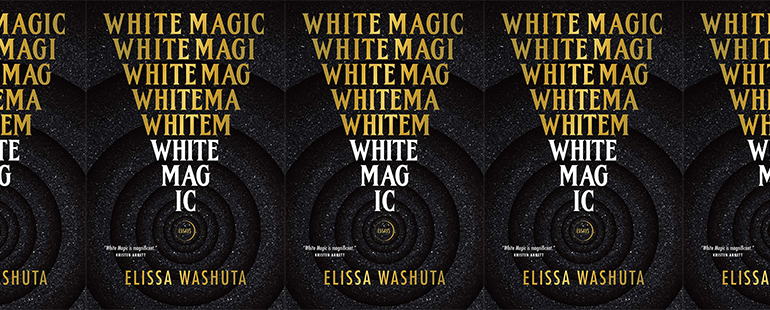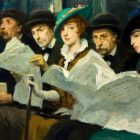The Many Narrative Layers of White Magic

“Elissa. What do you think you’re going to find on this trail?” muses Elissa Washuta in her new essay collection, White Magic, out this week. Throughout, Washuta builds essays that repudiate traditional structures, layering her own stories on existing forms as a means to examine the traumatic, defining moments of her life. She plays, for example, the video game Oregon Trail, heading west in-game like she headed west in-person, from New Jersey to Seattle. As a settler, Washuta travels west to take the lands of Coast Salish tribes—including from the Cowlitz Indian Tribe of which Washuta is a member—while off-screen she charts elements of her life along with Oregon Trail’s established narrative structure. Compelled by the archetypes of tarot cards, Washuta breaks the collection into three acts—like a tarot reading—and at the beginning of each, she meditates on readers’ expectations and how she will go about performing or subverting them. “This cannot be a comfortable time,” she begins Act II, “or else the narrative will slow and sag; it must be filled with threats”; then she heads into the messy middle. Act III begins with her expression of relief in finding resolution after finishing a draft of her work—though this is a resolution she ultimately withholds. “I will exit while I still have something at stake, something still to be gained or lost, because resolution has gone out of fashion,” she writes instead, warning the reader that her book will end where she thinks is best—for both the narrative and herself as a person processing the experiences within.
“You’ve always thought of the American West as a place where the land’s story recently got its stakes raised by revolver blasts, esophageal corrosion, torn petticoats, snapped necks, and stripped skulls,” Washuta writes. “You got sicker in the West, but maybe that was less about place than about time: the longer you lived, the worse you got, following your mapped trail to death by man or by poison.” In “Oregon Trail II For Windows 95/98/Me & Macintosh: Challenge the Unpredictable Frontier,” Washuta blurs the boundaries between the game and her life: it’s her esophagus she corrodes, binge drinking until she gets sober; it’s torn petticoats on the Oregon Trail, and her ancestors at the end of it facing the violence of white colonizers. In the west, Washuta was in a series of unhealthy relationships: she was smothered by a lover; she was raped; she was crushed by one who withdrew and who she could not let go of. On the trail, she must choose a treatment for her wounds. “Most of these treatment options seem fine,” Washuta writes, then continues, “outside the window, most options are bad. Gallbladder failure: Continue as usual or get surgery. Ovarian cysts: Continue as usual; Take Advil (though your inflamed stomach can’t handle it); Take Vicodin; Get a medical marijuana card.” Washuta adopts the language of the game to describe her own trajectory—from swilling NyQuil from a Gatorade bottle before homeroom to the “[l]and of the impossible: [her] young body riddled with rot . . . teeth turning dried-blood red from the inside.” She destroys her body, and so she must learn how to treat it; she’s never done so without the anesthetizing power of drugs and alcohol. “You’ve torn up your share of saloons,” she writes. “No, that’s not right—you’ve torn yourself up in your share of saloons.” As she plays the game, Washuta examines her past and situates it in the context of a longer history, while also scrutinizing and critiquing both narrative form and herself. “A trail is both more and less fixed than a narrative,” she notes. “When you’re writing the narrative, choices are infinite.” As she writes, she continues along the trail or else restarts the journey, asks new questions, seeks a different outcome. She calls the reader’s attention to her narrative decisions, then repositions a plot point, unfurling her story from another angle.
The Oregon Trail conceit also suits Washuta’s meditation on white settlers’ treatment of the land now known as Seattle and the Natives living on it, especially Duwamish, a Coast Salish tribe that is still not federally recognized. “The game was part of the project of whiteness: you were expected to colonize, to strive for an arrival into land theft, to see it as a great adventure, to see the Natives as helpers or hindrances or frightening shadows,” Washuta says. “[W]hiteness was still working hard to erase you, positioning its desires as the only ones that would lead to a win. This game has only two outcomes: death or settlement.” Here, again, Washuta blurs the boundaries of the game and her personal history: as a Native woman, she has a statistically higher chance of being raped (again) and of developing a substance use disorder. She drank so hard her body threatened to give out—“I lost hours, dollars, layers of lung, and neighborhoods of brain,” she says—just as white people hoped it would.
When she got sober, Washuta quickly learned that she needed to create a “drunkalogue,” another form she critiques for its capacity to meaningfully articulate her experience. “The more I told my story in rooms full of drying-out people, the more my narrative arc shaped itself into that of a rock star’s rise and fall,” she says. “Details became significant when they elicited gasps. I realized I was blessed with a garbage life full of narrative gems shinier than the diamonds studding the cocaine bottles that hung around Stevie Nicks’s neck.” Despite the gasps and gems, Washuta found the arc of the drunkalogue stilted: “The promise of a drink was never going to lead to discovery or completion or the kind of ending I want: resonant, a point of arrival,” she says. “This essay, I thought, could end with a look back at my entire drinking history and my triumphant recovery, but that’s boring.” Washuta, here, joins the conversation of what makes a good addiction story, which often dangerously dwells on drunkenness more than recovery and doesn’t always bring its storyteller any satisfaction. As Washuta and others note, the triumphant recovery part of the narrative is boring. Washuta lingers instead on earlier stages in the hero’s journey. “I couldn’t write a book, because a book is the dénouement of a problem worked through in life. I had to descend into the gloom, the underworld,” she says. “Writing a book is living out the final battle, a long face-off with what my mind has resisted resolving because it feels safe in the pain.” Pointedly, Washuta does not describe the writing process as cathartic, but neither does she shape her story into something purposefully palatable to a reader. She writes these essays for herself, to be traumatized and transformed by them. “I, arranger, am changed by having written these essays, and I come to you from a narrative present beyond them, but also still embedded in them,” she says. “I have asked my body to suffer a little more. My disorder demands that I feel the past in my body, like a medium channeling spirit.” Writing yields bodily suffering thanks to her PTSD; she can make a story from her suffering only by suffering again.
Washuta is a magician, performing the magic trick of assembling a narrative that cannot exist without the experimental process of writing it. “This book is a narrative. It has an arc,” she says. “But the tension is not in what happened when I lived it; it’s in what happened when I wrote it. Like I already told you, this is not just a recounted story; I am trying to make something happen and record the process and results.” She takes herself through a narrative wringer constructed of history: what white settlers did to the land and water and Coast Salish, and what bad boyfriends and drunken destruction did to her. “Any narrative is a magic trick: the unfolding happens where you’re not looking,” she says. “I wanted this narrative—this one, this story, this riddle, this experiment, this trick, this device—to teach me to love right, but all I know is that I’m not sure I can love a man who wouldn’t let me die. And maybe that means I can’t love a man if I want to live.” By splicing together existing narratives and her own struggles and trauma, Washuta is the magician who explains the trick as she goes while still managing to trick the audience in the end.
Washuta, importantly, identifies as a witch. Her rumination on this, too, provides the reader with a multi-layered analysis of the role. “We crystal witches of the internet think what we’re about is not New Age, but it surrounds us like water surrounds a fish,” she says. “I’m learning from Wikipedia that it’s exactly what we’re about, only we get our horoscopes as tweets and find our psychics on Yelp. We . . . seek what we can’t locate in the vast universe of the internet: reassurance that it will be okay.” There’s irreverence here—an awareness of who witches are in popular culture: our idea of who witches are comes from white people, who stole the identity from non-whites and stripped it. Washuta, though, is a witch as she wants to be, and as with narrative form, she’ll do with existing tropes as she wants: “I am a person with an internet connection and a credit card I can use to buy candles and charmed oils to cast the kind of spell that might rip a little hole in the world, the kind I might wish I could take back once it’s done,” she writes. “If I don’t follow the spells as written, am I really a witch? The truth is I’m not a witch, exactly: I’m a person with prayers, a person who believes in spirits and plays with fire.” Again we see Washuta ask questions and situate herself in history; we see her treats her wounds as best she can with whatever supplies she has in order to continue along the trail.
“I want to ungrow back into the child who truly believed in magic. I google spells to take the PTSD out of me,” Washuta says. Then, quickly, she reconsiders: “But is that what I want? To stop my brain from thrashing against the wickedness America stuffed inside me?” She can’t take the PTSD out, she concedes, but she can—and does—use it as a tool to process and structure her narrative. At the collection’s conclusion, she reaches the end of the trail, the place where the screen fades to black and the reader awaits the epilogue. Instead, Washuta forgoes a comforting conclusion and readies herself to restart the game. “I’m more interested in looking back to my curious and hopeful beginning, before I knew I would cry. I will start over. Do better this time.” The forms she uses here, she points out, are malleable in the writer’s process. She can follow the trail again, but ask different questions this time, make other trades, salve wounds with different treatments. She can do another tarot reading and arrange the archetypes into a narrative that yields something new.



